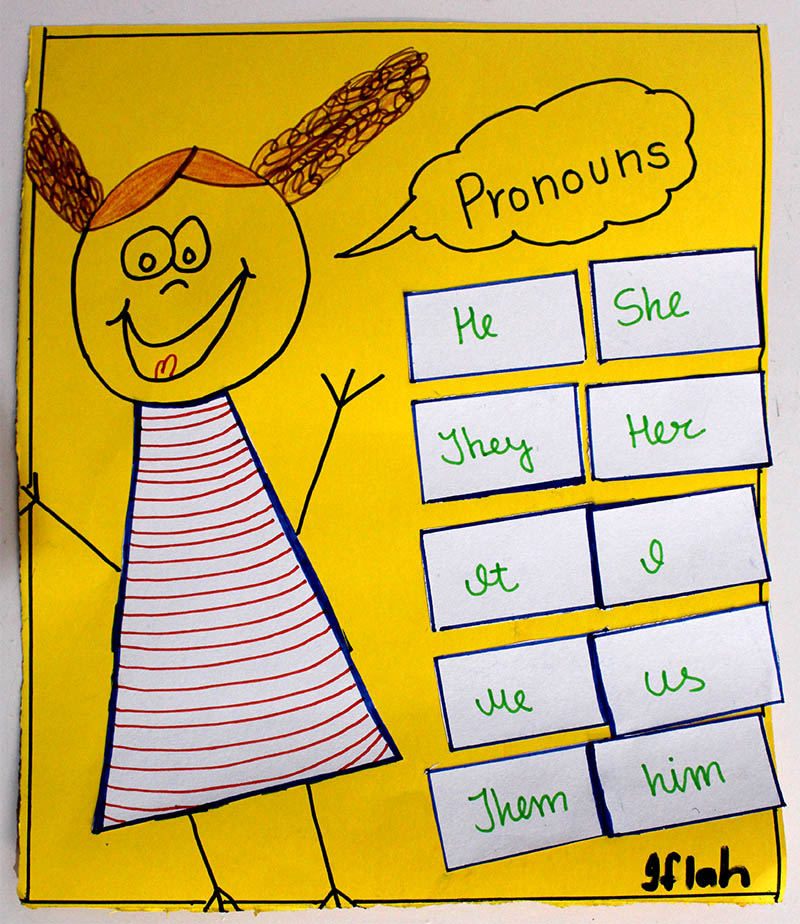
Fun activities for teaching English grammar
Objectives
Identification, improvement of fine motor skills, discrimination and memorization.
Fun activity for teaching pronouns
 “Pronoun girl” activity: It is an activity which is useful for teaching personal pronouns. It is a cutting and pasting activity which enables a child to learn personal pronouns in a fun way.
“Pronoun girl” activity: It is an activity which is useful for teaching personal pronouns. It is a cutting and pasting activity which enables a child to learn personal pronouns in a fun way.
Fun activity for teaching vowels
 “Five friends” activity: This activity is being for the purpose of teaching vowels and use of “an” with them. In this activity the ice-cream sticks look like “five friends” who are being protected by an elder friend called “an”.
“Five friends” activity: This activity is being for the purpose of teaching vowels and use of “an” with them. In this activity the ice-cream sticks look like “five friends” who are being protected by an elder friend called “an”.
Fun activity for teaching adjectives
“Adjective basket” activity: This activity is useful for teaching adjectives. The child was asked to write different adjectives on the pop-corn shaped pieces of paper and stick them on the bucket shaped piece of paper in order to make learning fun.
Fun activities for teaching nouns
Noun flower activity: It is a writing and coloring activity which is used for the purpose of teaching nouns to children. In this activity, a flower is drawn on a paper with only four petals and the child is told to sort the words written on the page into different categories (person, place, animal and things) and write them in the respective petals.
Fun activity for teaching gender
“He and she” activity: This activity was done with a child in order to make him understand the use of “he and she” in the sentences. The child was asked to cut the pictures from a newspaper and paste them on the cut-outs made by the teacher.
Learning in a fun way helps in involving the student in a kinesthetic approach, the impact of this learning lasts long and mostly helps children with reading issues to overcome their challenges.
Dyslexia is a general term for disorders that involve difficulty in learning to read or interpret words, letters and other symbols but that do not affect general intelligence. The word dyslexia is derived from the ‘dys’ means difficulty and ‘lexia’ means words. The combination of which implies difficulty in reading words. Dyslexia is a disability that affects millions of people all across the world.
We may look ahead and wonder if this learning issue will affect our child’s future.But dyslexia is not a prediction of failure .Dyslexia is quite common,and many successful individuals have dyslexia
Children with dyslexia may exhibit the following symptoms.
- A late talker
- Pronunciation problems
- Impaired ability to learn basics such as the alphabet,colors and numbers
- Problems with handwriting and other fine motor skills
- Confusing letters such as ‘b’ and ‘d’ or the orders of letters within words
- Trouble learning the connection between letters and their sounds
- Trouble in rhyming words
As the SEN department started working with the students, it was found that most of them were struggling with the English language skills. Keeping the needs in view, an initiative was taken to start a unit that could meet the needs of such students. It marked the beginning of English remedial unit in SEN in the year 2013. In the beginning only one teacher helped 13 students in improving their language skills. As time went on, students from main stream also joined SEN as they were found struggling in their regular academics due to their certain discrepancies in English language.
In the year 2015 English remedial department was expanded with five teachers teaching 40 students. The department has a separate library with over 2000 book that is particularly used by English remedial unit and SEN as a whole. In this department the teachers try hard to help these students to develop four core skills of English language i.e. reading/comprehension, writing, speaking and listening.


